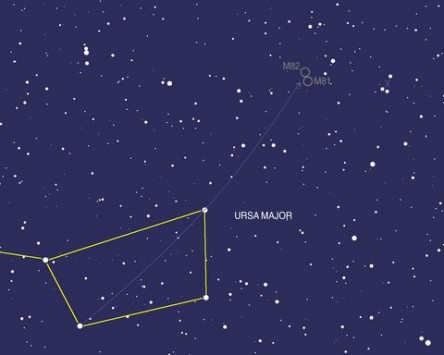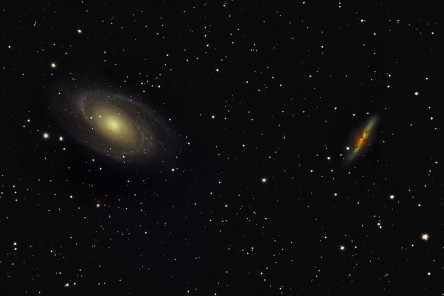Ah, spring, when a young (and old) astronomer’s fancy turns to thoughts of galaxies.
Our summer and winter views of the night sky are dominated by our own Milky Way Galaxy but during the spring and autumn the Earth is positioned in such a place within its orbit around the Sun that we get an open window to the regions of space that lie beyond our own “island universe” and, consequently, we get to see other galaxies. By way of definition, a galaxy is a vast collection of stars, dust, and interstellar gas all bound together by gravity.
Galaxies come in a variety of shapes and sizes. The spiral galaxies are perhaps the most familiar to us (our Milky Way Galaxy is itself a spiral galaxy) and are characterized by being shaped like a flat disc, with a central bulge of stars, and those majestic spiral arms radiating out from the central hub. These “island universes” may contain hundreds of billions of stars. Elliptical galaxies are, just as the name suggests, somewhat football-shaped and are rather featureless. Rather than having spiral arms they seem to be nothing more than a dense central core with stars wrapped around it. Elliptical galaxies contain little gas and dust (the stuff that new stars are made from) and are made up mostly of old stars. They also tend to be much bigger than our Milky Way Galaxy (10x or more the diameter of our home galaxy) and may contain trillions of stars. Some 60% of all galaxies are ellipticals. And, finally, we have irregular galaxies. These are small, amorphous kinds of galaxies that are neither elliptical nor spiral in shape. Irregular galaxies may contain as few as a million stars and a good example of an irregular would be the Large and Small Magellanic clouds, dwarf galaxies that orbit the much larger Milky Way Galaxy. About 20% of all galaxies fall into the irregular galaxy category.
HOW TO FIND BODE’S GALAXY (MESSIER81) AND THE CIGAR GALAXY (MESSIER 82)
 First off, you will need to be under at least moderately dark skies to observe this pair of lovelies. Now, find the Big Dipper. With the aid of a star map or app, locate the stars Phecda and Dubhe (they are both stars that form part of the dipper’s bowl). Draw an imaginary diagonal line between these two stars. From Dubhe, extend this line along the same trajectory for about the same distance again and you will come to the spot where M81 and M82 reside, approximately 10 degrees from Dubhe. Your fist held out at arm’s length is about 10 degrees wide.
First off, you will need to be under at least moderately dark skies to observe this pair of lovelies. Now, find the Big Dipper. With the aid of a star map or app, locate the stars Phecda and Dubhe (they are both stars that form part of the dipper’s bowl). Draw an imaginary diagonal line between these two stars. From Dubhe, extend this line along the same trajectory for about the same distance again and you will come to the spot where M81 and M82 reside, approximately 10 degrees from Dubhe. Your fist held out at arm’s length is about 10 degrees wide.
WHAT YOU ARE SEEING
Through binoculars and small telescopes this wonderful pair of galaxies appear as two hazy eye-like patches of light glowing against the dark background of space. M81, the brighter of the two, appears as an oval while M82 is more spindle, or cigar-shaped. Larger aperture scopes and photography will of course reveal more detail, including the spiral arm structure of M81. The reason that we see these galaxies as two distinct shapes has to do with the way that they are oriented to our line of sight. M81 is tilted at an oblique angle, giving us a near “bird’s eye” view while M82 is seen edge on.
M81 is a great example of what’s known as a “grand design” spiral arm galaxy, a galaxy which exhibits distinct, well defined spiral arm structure. The core of M81 is quite prominent as it is very densely packed with stars, lurking within its center is a supermassive black hole estimated to be around 60 to 70 million solar masses. Photographs of the galaxy reveal the core to be diffused with a faint yellow color, a sure sign that older, cooler stars are packed into this region. The spiral arms however show a distinct blue, white, and pink- a sure indication of the presence of young, hot stars.
M82 was once thought to be an irregular galaxy but a study in 2005 showed that, when observed in the near infrared, the galaxy shows two symmetric spiral arms.
M81/82 are most assuredly locked in a gravitational embrace and have apparently interacted with one another many millions of years ago. As the two danced close together eons ago the gravitational tidal tug from M81 set off a density wave ripple in M82. As this wave propagated through the dust and gas of the galaxy it triggered a burst of star formation. Photographs of M82 seem to show explosions of gas emanating from near the galaxy’s core, whether this is material being blown out from the core or merely light being reflected off gas that is stationary is still a matter of conjecture.
While M81/82 are some 11 million light years from Earth they are only about 100,000 light years from each other. If you were on a planet orbiting a star in either galaxy, just imagine what your view might be like as you looked up into a night sky dominated by the presence of your galactic neighbor.
